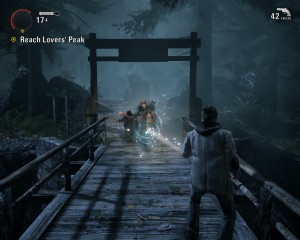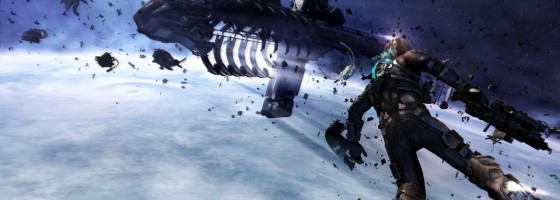Moving from the indie market, my next game was a full blown AAA title and an attempt to revive survival horror following the Resident Evil series transformation. Dead Space got atmosphere and enemy design right, but went too far with giving the player power.
Dead Space:
The Dead Space series followed Isaac Clark, an engineer who discovers an object called the beacon that causes insanity while turning people into necromorphs — undead monsters who can only be killed by severing their limbs.
One thing that Dead Space got right was delivering on an aesthetic style. The space stations that the first two games took place in looked great while delivering that sense that something went wrong there. The game’s UI was smartly integrated into Isaac’s suit instead of having basic menus. All the maps, inventory screens, objectives and more were a part of his suit. Even his health was displayed via bars on the back where his spine was.
Enemies had that “The Thing” quality to them which made them all the more terrifying to fight and the game was all about that one man against evil that we saw in classic games like Doom. But where Dead Space went wrong in the horror department was relying too much on action.
Dead Resident Space:
Dead Space copied wholesale from Resident Evil 4 in how combat worked. The entire game was played over the shoulder and the player was constantly assaulted by enemies. The problem is that where Outlast and Knock-Knock kept encounters to a minimum, Dead Space went all out. Instead of the player becoming bored because there was nothing to fight, here they became bored after constantly being attacked by the same enemies.
It’s the classic horror trap that the more you see or learn about the enemy, the less scary they become. Case in point the Hellraiser series and how after 8 movies, there was nothing more they could do with Pinhead (although the same could be said after 3.) And as the Dead Space series went on, the horror aspect became more and more downplayed in favor of more action.

Alan Wake despite having far less weaponry also suffered by having too many encounters that played out the same way.
Not helping matters was the player’s weaponry which made them able to outmatch almost every enemy in the game.
It’s hard to feel scared when you have a rocket launcher or rail gun on hand. And these weapons were used to kill the same enemies time after time and by the end of the game, I was more concerned with coming up with witty lines rather than being scared.
This is also the same problem that Alan Wake had and how the lack of diverse enemies and situations made the game run out of steam in the horror department before the game was up.
Quality Monsters:
The key to balancing horror and action in my opinion is having less frequent but stronger enemies to fight. You should not have a kill count in the dozens by the time the game is up and each enemy should challenge the player beyond just running at them in a straight line.
Every enemy, even the ones considered “scrubs” should present a unique encounter to the player. In the horror idea I came up with, every enemy type was completely different including special onetime enemies that acted as mini bosses. I would love to see someone attempt to combine Shadow of the Colossus’s style of only having a few unique bosses enemies with a horror game and see how that would play out.
Up next, I turn to a series that has garnered a lot of praise yet is one of my least favorite.


